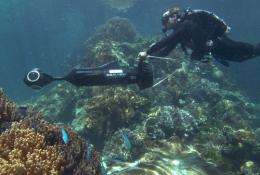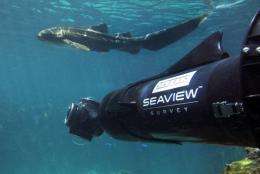Panoramic images of Great Barrier Reef will take millions on virtual dives

Internet surfers will soon be able to go below the surface to immerse themselves in the spectacular coral and marine life of the Great Barrier Reef, under a joint venture between global technology giant Google, the University of Queensland Global Change Institute and insurance company Catlin.
The Catlin Seaview Survey camera, developed for the expedition, will capture 50,000 360-degree underwater panoramas from the reef, which will then be uploaded to Google Earth and Google Maps.
The project’s chief scientist, Professor Ove Hoegh-Guldberg, who is Director of the Global Change Institute at The University of Queensland, said the project would gather data to give scientists a better understanding of the impact of climate change and other environmental factors on ocean ecosystems.
“The visual nature of the project will also help bridge the gap between scientific knowledge and public awareness,” Professor Hoegh-Guldberg said.

“The Catlin Seaview Survey comprises a series of studies which will reveal to the public one of the last frontiers on Earth: the oceans.
“For the first time in history, we have the technology to broadcast the findings and expedition through Google. Millions of people will be able to experience the life, the science and the magic that exists under the surface of our oceans.”
The project, which will launch in September 2012, will be broadcast on a dedicated YouTube channel. With the aid of Google Hangouts video technology, internet users will be able to watch live streaming videos of dives by the expedition team.
The survey of the world’s largest coral reef system will be conducted at three levels: a shallow reef survey, a deep reef survey and a megafauna survey. Together they will provide a clearer picture of the composition, biodiversity and wellbeing of the reef.
The shallow survey will provide a rapid census of corals, fish and other organisms at 20 sites across the 2300-kilometre length of the reef.
For the deep reef survey, the team will use diving robots to explore depths of 30-100 metres. Little is known of this region, yet it may hold some of the secrets of whether or not the coral reefs will survive rapid climate change, Professor Hoegh-Guldberg said.
Emmy award-winning cinematographer and shark researcher Richard Fitzpatrick will lead a team carrying out the megafauna survey, for which they will study the migratory patterns of tiger sharks, green turtles and manta rays in response to rising water temperatures. The team will use satellite tags to track 50 animals.
Climate change has caused mass coral bleaching across the reef on three occasions in the past 15 years, and is considered the greatest threat to its future, according to the Great Barrier Reef Marine Park Authority. Water pollution and fishing are also major threats.
Source: The Conversation
This story is published courtesy of the The Conversation (under Creative Commons-Attribution/No derivatives).
















